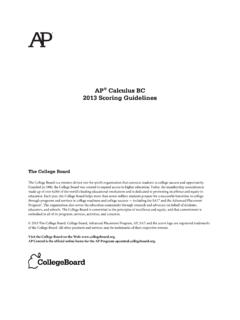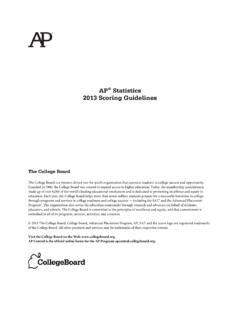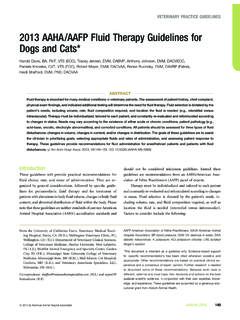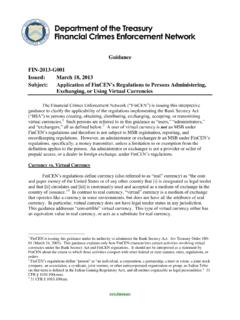Transcription of Guidelines for the Practice of Telepsychology
1 Guidelines for the Practice of TelepsychologyJoint Task Force for the Development of Telepsychology Guidelines for PsychologistsThese Guidelines are designed to address the developingarea of psychological service provision commonly knownas defined, for the pur-pose of these Guidelines , as the provision of psychologicalservices using telecommunication technologies, as ex-pounded in the Definition of Telepsychology section ofthese Guidelines . The expanding role of technology in theprovision of psychological services and the continuousdevelopment of new technologies that may be useful in thepractice of psychology present unique opportunities, con-siderations, and challenges to Practice . With the advance-ment of technology and the increased number of psychol-ogists using technology in their practices , these guidelineshave been prepared to educate and guide Guidelines are informed by relevant AmericanPsychological Association (APA) standards and Guidelines ,including the Ethical Principles of Psychologists and Codeof Conduct ( APA Ethics Code ; APA, 2002a, 2010) andthe Record Keeping Guidelines (APA, 2007).
2 In addi-tion, the assumptions and principles that guide APA s Guidelines on Multicultural Training, Research, Practice ,and Organizational Change for Psychologists (APA,2003) are infused throughout theRationaleandApplicationsubsections describing each of the Guidelines . Therefore,these Guidelines are informed by professional theories,evidence-based practices , and definitions in an effort tooffer the best guidance in the Practice of use of the termguidelineswithin this documentrefers to statements that suggest or recommend specificprofessional behaviors, endeavors, or conduct for psychol-ogists. Guidelines differ from standards in that standardsare mandatory and may be accompanied by an enforcementmechanism.
3 Thus, Guidelines are aspirational in are intended to facilitate the continued systematicdevelopment of the profession and to help ensure a highlevel of professional Practice by psychologists. Guidelinesare created to educate and to inform the Practice of psy-chologists. They are also intended to stimulate debate andresearch. Guidelines are not to be promulgated as a meansof establishing the identity of a particular group or specialtyarea of psychology; likewise, they are not to be createdwith the purpose of excluding any psychologist from prac-ticing in a particular area (APA, 2002b, p. 1048). Guide-lines are not intended to be mandatory or exhaustive andmay not be applicable to every professional or clinicalsituation.
4 They are not definitive and they are not intendedto take precedence over the judgment of psychologists (APA, 2002b, p. 1050). These Guidelines are meant toassist psychologists as they apply current standards ofprofessional Practice when utilizing telecommunicationtechnologies as a means of delivering their professionalservices. They are not intended to change any scope ofpractice or define the Practice of any group of Practice of Telepsychology involves considerationof legal requirements, ethical standards, telecommunica-tion technologies, intra- and interagency policies, and otherexternal constraints, as well as the demands of the partic-ular professional context. In some situations, one set ofconsiderations may suggest a different course of actionthan another, and it is the responsibility of the psychologistto balance them appropriately.
5 These Guidelines aim toassist psychologists in making such decisions. In addition,it will be important for psychologists to be cognizant of andcompliant with laws and regulations that govern indepen-dent Practice within jurisdictions and across jurisdictionaland international borders. This is particularly true whenproviding Telepsychology services. Where a psychologist isproviding services from one jurisdiction to a client/patientlocated in another jurisdiction, the law and regulations maydiffer between the two jurisdictions. Also, it is the respon-sibility of the psychologists who Practice Telepsychology tomaintain and enhance their level of understanding of theconcepts related to the delivery of services via telecommu-nication technologies.
6 Nothing in these Guidelines is in-tended to contravene any limitations set on psychologists activities based on ethical standards, federal or jurisdic-tional statutes or regulations, or for those psychologistswho work in agencies and public settings. As in all othercircumstances, psychologists must be aware of the stan-The Guidelines for the Practice of Telepsychology were developed bythe Joint Task Force for the Development of Telepsychology Guidelinesfor Psychologists established by the following three entities: the AmericanPsychological Association (APA), the Association of State and ProvincialPsychology Boards (ASPPB), and the APA Insurance Trust (APAIT). The Guidelines for the Practice of Telepsychology were approved as APApolicy by the APA Council of Representatives on July 31, 2013 .
7 Theco-chairs of the joint task force were Linda Campbell and Fred Mill members of the task force included the following psycholo-gists: Margo Adams Larsen, Sara Smucker Barnwell, Bruce E. Crow,Terry S. Gock, Eric A. Harris, Jana N. Martin, Thomas W. Miller, andJoseph S. Rallo. APA staff (Ronald S. Palomares, Deborah Baker, JoanFreund, and Jessica Davis) and ASPPB staff (Stephen DeMers, Alex , and Janet Pippin Orwig) provided direct support to the joint Guidelines are scheduled to expire as APA policy 10 yearsfrom July 31, 2013 (the date of their adoption by the APA Council ofRepresentatives). After this date, users are encouraged to contact the APAP ractice Directorate to determine whether this document remains in concerning these Guidelines should be addressed tothe Practice Directorate, American Psychological Association, 750 FirstStreet, NE, Washington, DC 2013 American Psychologist 2013 American Psychological Association 0003-066X/13/$ 68, No.
8 9, 791 800 DOI: of Practice for the jurisdiction or setting in whichthey function and are expected to comply with those stan-dards. Recommendations related to the Guidelines are con-sistent with broad ethical principles (APA Ethics Code,APA, 2002a, 2010), and it continues to be the responsibil-ity of the psychologist to apply all current legal and ethicalstandards of Practice when providing Telepsychology should be noted that APA policy generally requiressubstantial review of the relevant empirical literature as abasis for establishing the need for Guidelines and for pro-viding justification for the Guidelines statements them-selves (APA, 2002b, p. 1050). The literature supporting thework of the Joint Task Force on the Development ofTelepsychology Guidelines for Psychologists ( , the Te-lepsychology Task Force) and the Guidelines statementsthemselves reflect seminal, relevant, and recent publica-tions.
9 The supporting references in the literature reviewemphasize studies from approximately the past 15 yearsplus classic studies that provide empirical support andrelevant examples for the Guidelines . The literature review,however, is not intended to be exhaustive or to serve as acomprehensive systematic review of the literature that iscustomary when developing professional Practice guide-lines for of TelepsychologyTelepsychologyis defined, for the purpose of theseguidelines, as the provision of psychological servicesusing telecommunication technologies. Telecommunica-tions is the preparation, transmission, communication, orrelated processing of information by electrical, electro-magnetic, electromechanical, electro-optical, or elec-tronic means (Committee on National Security Systems,2010).
10 Telecommunication technologies include but arenot limited to telephone, mobile devices, interactivevideoconferencing, e-mail, chat, text, and Internet ( ,self-help websites, blogs, and social media). The infor-mation that is transmitted may be in writing or includeimages, sounds, or other data. These communicationsmay be synchronous, with multiple parties communicat-ing in real time ( , interactive videoconferencing,telephone), or asynchronous ( , e-mail, online bulletinboards, storing and forwarding of information). Tech-nologies may augment traditional in-person services( , psychoeducational materials posted online after anin-person therapy session) or be used as stand-aloneservices ( , therapy or leadership development pro-vided over videoconferencing).
















